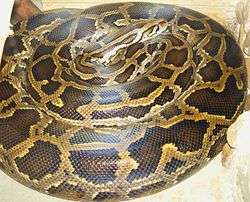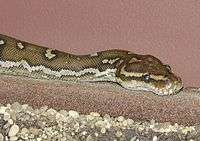Python (genus)
| Python | |
|---|---|
 | |
| Burmese python, Python bivittatus | |
| Scientific classification | |
| Kingdom: | Animalia |
| Phylum: | Chordata |
| Class: | Reptilia |
| Order: | Squamata |
| Suborder: | Serpentes |
| Family: | Pythonidae |
| Genus: | Python Daudin, 1803 |
| Synonyms | |
| |
Python, from the Greek word (πύθων/πύθωνας), is a genus of nonvenomous pythons[2] found in Africa and Asia. Until recently, seven extant species were recognised;[2] however, three subspecies have been promoted and a new species recognised. A member of this genus, P. reticulatus, is among the longest snake species and extant reptiles in the world.
Geographic range

In Africa, members of the genus are found in the tropics south of the Sahara, but not in the extreme south-western tip of southern Africa (Western Cape) or in Madagascar. In Asia, they are found from Bangladesh, Nepal, India, Pakistan, and Sri Lanka, including the Nicobar Islands, through Myanmar, east to Indochina, southern China, Hong Kong and Hainan, as well as in the Malayan region of Indonesia and the Philippines.[1]
Some suggest that P. molurus and P. sebae have the potential to be problematic invasive species in South Florida.[3] The United States Department of Agriculture reports that only Python molurus bivittatus is an invasive species in the United States.[4] In early 2016, after a culling operation yielded 106 of the animals, Everglades park officials suggested that "thousands" may live within the park, and that the species has been breeding there for some years. More recent data suggest that these pythons would not withstand winter climates north of Florida, contradicting previous research suggesting a more significant geographic potential range.[5][6]
Species
*) Not including the nominate subspecies.
T) Type species.[1]
Uses

Python skin is used to make clothing, such as vests, belts, boots and shoes, or fashion accessories, such as handbags. It may also be stretched and formed as the sound board of some string musical instruments, such as the erhu spike-fiddle, sanxian and the sanshin lutes.[12][13]
As pets
Many Python species, such as P. regius, P. brongersmai, P. bivittatus and P. reticulatus, are popular to keep as pets due to their ease of care, docile temperament, and vibrant colors, with some rare mutations having been sold for several thousands of dollars. Despite controversy that has arisen from media reports, with proper safety procedures pet pythons are relatively safe to own,[14] and deaths associated with them are isolated compared to other domestic animals, such as dogs and horses.[13][15]
See also
- List of pythonid species and subspecies
- Pythonidae by common name
- Pythonidae by taxonomic synonyms
References
- 1 2 3 4 McDiarmid RW, Campbell JA, Touré T. 1999. Snake Species of the World: A Taxonomic and Geographic Reference, vol. 1. Herpetologists' League. 511 pp. ISBN 1-893777-00-6 (series). ISBN 1-893777-01-4 (volume).
- 1 2 3 4 5 "Python". Integrated Taxonomic Information System. Retrieved 11 September 2007.
- ↑ Python Snakes, An Invasive Species In Florida, Could Spread To One Third Of US at ScienceDaily. Accessed 18 October 2008.
- ↑ Invasive Species: Animals. Invasivespeciesinfo.gov. Retrieved on 2013-07-17.
- ↑ Avery, M. L., Engeman, R. M., Keacher, K. L., Humphrey, J. S., Bruce, W. E., Mathies, T. C., & Mauldin, R. E. (2010). Cold weather and the potential range of invasive Burmese pythons. Biological invasions, 12(11), 3649-3652.http://www.invasivespeciesinfo.gov/animals/main.shtml
- ↑ Python Snakes, An Invasive Species In Florida, Could Spread To One Third Of US
- ↑ http://www.catalogueoflife.org/col/browse/classification/kingdom/Animalia/phylum/Chordata/class/Reptilia/order/Squamata/family/Pythonidae/genus/Python/match/1
- ↑ http://www.iucnredlist.org
- ↑ http://novataxa.blogspot.com/2012/01/2011-python-kyaiktiyo-myanmar.html
- ↑ http://www.iucnredlist.org/details/199854/0
- ↑ "Annotated checklist of the recent and extinct pythons".
- ↑ http://erhuworld.com/
- 1 2 http://www.asovivasanshin.com/introduction.html
- ↑ http://www.anapsid.org/handling.html
- ↑ http://www.anapsid.org/pdv-boid.html
External links
| Wikimedia Commons has media related to: |
| Wikisource has the text of a 1920 Encyclopedia Americana article about Python (genus). |
- Python at the Reptarium.cz Reptile Database. Accessed 11 September 2007.
.jpg)
.jpg)


.jpg)





.jpg)